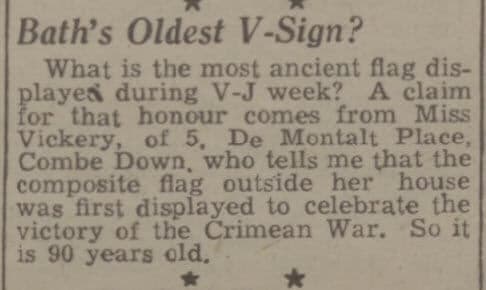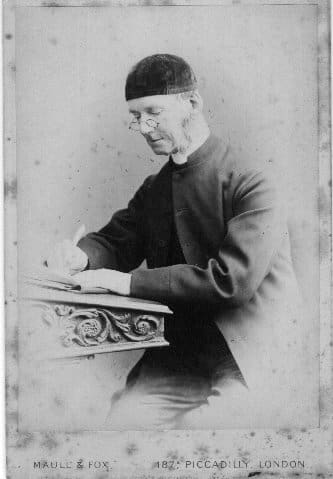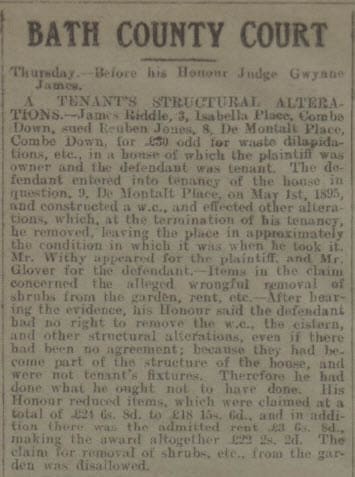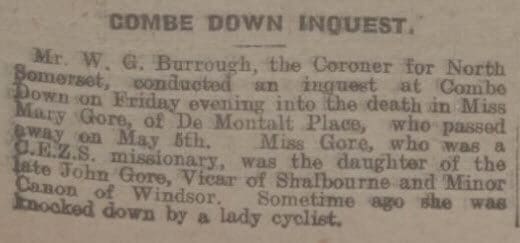1901 – Rev Reginald Guy Bryan
The Rev Reginald Guy Bryan (1819 – 1912) was living at 6 De Montalt Place in 1901, together with his third wife Caroline Letitia Gore (1843 – 1920) whome he married in 1896.
She was the daughter of Mary Eliza Gore (née Hole) (1813 – 1891) who had lived there previously.
He was the son of Rev Guy Bryan (1782 – 1870), who was the Rector at South Normanton, Derbyshire and then Rector at Woodham Walter, Essex, and Selina Elizabeth Eardley-Wilmot (1781 – 1868).
He studied at Rugby School under Dr Thomas Arnold (1795 – 1842) and went to Gonville and Caius College, Cambridge but migrated to Trinity College, Cambridge gaining a BA in 1842 which was also when he was ordained.
He then became curate of Yelden in Bedfordshire from 1844 to 1846, then Perpetual Curate of Brightside at sheffield from 1846 to 1847.
From 1847 – 1856 he became Vice Principal of The Protestant College, Malta.
From 1856 – 1875 he was Perpetual Curate of Fosbury in Wiltshire before becoming Principal at Monkton Combe School from 1875 until 1894.
His first marriage was to Henrietta Garnham Luard (1817 – 1849) daughter of William Wright Luard (1741 – 1802) JP DL of Witham Lodge, Witham, Essex and Charlotte Garnham (1789 – 1875).
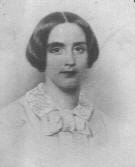
He then married Salome Blomefield (1827 – 1894) the daughter of Sir Thomas William Blomefield (1791 – 1858) and Salome Kekewich (1795 – 1862) and had 10 children, 4 boys and 6 girls.
The Bryan family were related to many others on Combe Down.
Helen Gertrude Bryan (1860 – 1917) married Rev Charles Howard (1853 – 1928) and Edith Mary Marow Bryan (1866 – 1951) married Rev Alfred Howard (1857 – 1945).
Both were sons of Rev Thomas Henry Howard (1804 – 1885) whose other son Rev Richard Nelson Howard (1852 – 1932) was vicar of Combe Down from 1892 – 1897.
The Howard family were also related to Rev Alfred Richardson (1853 – 1925) was vicar of Combe Down from 1902 – 1914.
The Bryan family were related to the Gore family via Caroline Letitia Gore (1843 – 1920) the third wife of Rev Reginald Guy Bryan (1819 – 1912).
The Gore family were related to the Daubeny / Daubeney family via Edith Henrietta Gore (1852 – 1931) Caroline’s sister and wife to Capt Charles William Daubeney (1860 – 1937).
The Daubeney’s lived at The Brow.
1906 – Mary Vickery sues her brother
We touched on John Pearce (1852 – 1925) & Mary (née Vickery) (1855 – 1939) Vickery who lived at 5 De Montalt Place previously.
In 1906 Mary Vickery appealed a case previously won by her brother Thomas Vickery (b. 1855) about a house that he claimed their father had given to him and she claimed should be part of his estate.
Their father’s will had not specifically stated the house was his.
The will said “I bequeath my house at Trumps to my son Thomas”.[1]
The problem was that there was No. 1 Trumps and No. 2 Trumps.
Their father had lived at No.1 Trumps and the Court of Chancery decided that was the house intended for Thomas and that No. 2 Trumps fell into the residue of the estate which went to Mary Vickery. The Court of Appeal agreed.
However her brother said that No.2 Trumps had been given to him by their father in 1884 and that he had been in undisputed possession although it had not been transferred to him by deed but that, even so, he had acquired statutory or promissory title and went to the County Court at Taunton who found in his favour[2].
Mary Vickery, therefore, appealed to the High Court and said the case was res judicata or already decided.
It appears the case in Chancery had not taken evidence about the gift and nor had the County Court and so the High Court said a retrial was necessary.
This took place on Tuesday 20 March 1906 at Taunton County Court in front of the same judge as previously, Judge Beresford.[3]
This time evidence about the gift element was heard and Mary Vickery lost the case. She had to pay her brother’s costs for the appeal to the high court and the second trial at Taunton.
1916 Reuben and Ann (née Newman) Jones 8 & 9 De Montalt Place
Reuben Jones (1860 – 1918) and his wife Ann Newman (b. 1861) are shown in the 1901 and 1911 census. He was originally a mason’s labourer but in the 1880s had become a cellarman at a brewery.
He and his family moved to 9 De Montalt Place in 1895 renting from James Riddle. At some point he had moved from 9 De Montalt Place to 8 De Montalt Place and it seems he took the WC & cistern he had installed, along with some other things, when he moved.
James Riddle sued for £24 6s 8d arguing that they had become part of the structure of the house and should not have been taken. He won but got £18 15s 6d.
It’s worth noting that in 1915, around 90% of all UK households were tenants. By 1939 home ownership had risen to 33%, by 1961 it was 44.4% and by 1991 68%. English home ownership is now 63.8%.
Even so, many of us do not realize that our freehold property is, technically or legally not really ours.
The English system of land law can be traced back to the Norman conquest of 1066, after which William II declared himself absolute owner of the entire country. Any existing forms of land ownership were therefore swept away. The concepts of leasehold and freehold derive from medieval forms of tenure and are not ownership, land cannot be owned, except by the monarch.
In February 2009, Bridget Prentice, a parliamentary undersecretary at the Ministry of Justice stated “The Crown is the ultimate owner of all land in England and Wales (including the Isles of Scilly): all other owners hold an estate in land. Although there is some land that the Crown has never granted away, most land is held of the Crown as freehold or leasehold”.
An estate in land is basically the rights and interests a person has over a plot of land and it is actually the benefits and rights of that land you actually purchase.
1925 – Miss Mary Gore
In 1925 Mary Gore (1838 – 1925) the daughter of Rev John Gore (1800 – 1871) and Mary Eliza Gore (née Hole) (1813 – 1891) died some time after being knocked over by a cyclist.
She had been living at 7 De Montalt Place and the clipping shows her household effects that were auctioned.
The inquest clipping states she was a C.E.Z.S. missionary.
C.E.Z.S. stands for the Church of England Zenana Missionary Society.
This was founded in 1880 when it separated from the Indian Female Normal School Society (founded 1852).
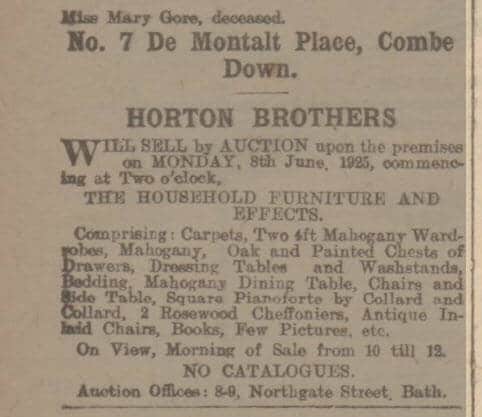
Its main aim was to evangelise the women of India by means of normal schools, zenana visiting, medical missions, Hindu and Muslim female schools and the employment of Bible women.
The Society was to work in close co-operation with the Church Missionary Society.
The society started in India but spread to China in 1884, Japan in 1886 and Ceylon (now Sri Lanka) in 1889
1939 – 1949 Mary Vickery and Milford Isobel Vickery
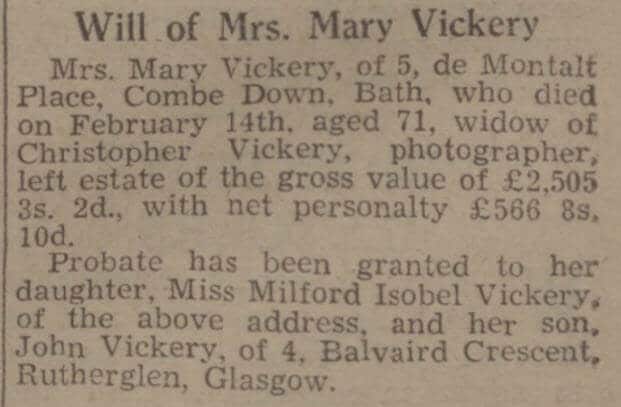
Mary Vickery, who had lost the court case, with her brother, about her father’s will died in 1939 leaving £2,505 3s 2d – about £377,600.00 in 2016[4].
Unfortunately the snippet in the paper got her late husband’s name (John) and her age incorrect. She was 85. The family’s death notice corrected the errors – Bath Chronicle and Weekly Gazette, Saturday 18 February 1939.
In 1945 Mary’s daughter, Milford Isobel Vickery (1888 – 1962) claimed to have ‘Bath’s Oldest V Sign’ for V-J week.
Some 4 years later she had an accident at Victoria Art Gallery.
In the same year there was discussion about the name of Church Road based on the fact that the Ordnance Survey maps of Combe Down after 1899 called Church Road by De Montalt Road.
As we all now know the decision to continue with Church Road was made.
However, the various names of the rows and terraces used locally e.g. Isabella Place, De Montalt Place also continued leading to some confusion.
In 1957 street numbering for Church Road was introduced.
